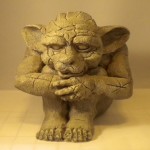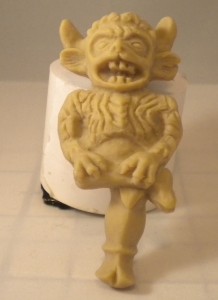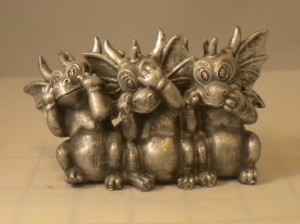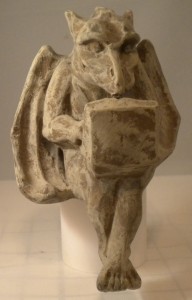
I had mentioned in my last post my collection of “gargoyles”. I thought I would introduce a few of them to you today, but first a little history lesson. Most stone carvings people think of as gargoyles are not. True gargoyles are actually rain or run-off spouts for buildings and churches. The sit poised at the corners and eaves of rooftops with their mouths open to funnel the water away from vulnerable spots. The word “gargoyle” comes from the early French for “throat”, and some scholars think that it is actually a oenomatopedic word for “gargle”. The creatures that we see, with wings spread, gazing down so disdainfully at us are actually “grotesques”. Their presence has been debated by scholars, artists, and historians over the years, but the general concensus seems to be this: grotesques may have been placed by superstitious builders to ward off evil, both to the structure and to those inside it. Some people believed that they actually came to life at night, flying around an playing pranks. They were also used as both signatures by the masons and stonecrafters to sign their work, and also as private jokes by those same people.
Whatever their purpose, they are a charming and enigmtic addition to structures– mostly in England and France. My collection began with a kitchen magnet. My friends saw it, and decided that it must have companions. Over the years, very few of my creatures have actually been purchased by myself. Because of my interest in things historical, I have ventured to give my collection the names of saints, pairing their general appearance with the appropriate saint. You’ll see what I mean below. Not all of them have names. Some have defied all logic, and some only need a general description to keep their place.
This first little guy is named after Saint Matthew, the patron saint of bookkeepers, bankers, accountants, and moneylenders. He is actually a bank. You can see him hovering over his money, keeping a wary eye out for borrowers and thieves.
My second fellow pictured here is modelled after the Beanie Babies. Because he is sewn together, I have named him after Saint Homobonus, the patron saint of tailors.
The groteque to the right has an interesting history. As you can see from the pictures so far, some of my collection are historical repplications, and some are modern whimsical adaptations. This one is definitely historical. My husband and I several years ago had the good fortune to go to England, and visited many churches and cathedrals there. In Lincoln, the cathedral has a grotesque called simply “the imp”. He is quite small and easy to miss, as he is up near the vaulted ceiling. Tradition has it that at night an imp from Hell would come to the cathedral and fly around, taunting the statues of the saints. As punishment, he was turned to stone and placed in the cathedral as a warning to other minions of Satan. Some say that at night he still comes to life and flies around. So this is simply “The Lincoln Imp”.
The creature to the left here is actually a true gargoyle. you can see how he is poised to spew water from a handy downspout. Spew is the operative word here. I have named him after the Saint Elmo, the patron saint of stomach disorders. 
These little guys are so cute, they don’t need names. If you examine them closely, you’ll see that they are the grotesque version of “hear no evil, see no evil, speak no evil”. But they’re so cute, who would get annoyed being reprimanded by them?
OK–one more for now. This fella is very obviously a modern grotesque adaptation. He’s very studiously working on a laptop. He’s been named after the patron saint of lost causes, Saint Jude. I tell everyone he’s working on a Mac. It really gets my sister annoyed, as she is a dyed in the wool Mac person.
Well, I hoped you enjoyed the little tour. I apologize for some of the chopped pictures. I don’t know why my computer is doing this. I will correct them as soon as I can. I have many more gargoyles in my collection, and I’ll introduce you to them over time. Some are very unusual, in various media.
See you soon!


I like gargoyles, especially in their original architectural form, because they show the human need to put artistic expression into what could be a very plain utilitarian structure.
I won’t get into the Mac thing. I know they’ve won the war when it comes to depiction of laptops in movies.